Verification of the effectiveness of AZOTER F soil bacteria fertilizer in the plant stands of winter wheat and spring barley
![]()
![]()
Report of the results from semi-operational experiments from 2020 in the certified organic farming company
* * *
Ing. Tomáš Javor, DiS., Ing. Lenka Beranová, DiS. a kol., AGROEKO Žamberk spol. s r.o.
Ing. Petr Tomaško, ZEOS, s.r.o. Prostřední Lipka
Jiří Řezníček, AZOTER CZ s.r.o.
Winter wheat in the cadastral area of Dolní Morava (Ústí nad Orlicí district)
soil type: medium heavy (gleyic cambisol and modal planosol and stagnosol on granite, gneiss, and other solid rocks) slightly to medium rocky, with a tendency to temporary wetting, average altitude: 662 m
| Soil PH | Content of available nutrients (mg/kg of soil) | Cox. | |||
| pH/CaCl2 | P | K | Ca | Mg | (%) |
| 6,17 | 80 | 583 | 2891 | 328 | 2,3 |
| Slightly acidic | Satisfactory | Very high | Good | High | High |
Tab. 1. Agrochemical properties of soil on land before application of AZOTER products (October 7, 2019)
The application of AZOTER F bacterial fertilizer (10 l / ha) was carried out after plowing, on the day of sowing the winter wheat on 15 October 2019 with an installed applicator for a combined pre-sowing tiller (compactor). Pre-sowing tilling was performed to a depth of 5 – 6 cm. A stand with the Vanessa variety (quality C) was established. The harvest of the winter wheat was on August 26, 2020.
AZOTER F bacterial fertilizer was applied in a company that is focused on ecological way of farming. Before sowing on 2 October 2019, cattle manure was applied to the monitored plot at a rate of 30 t / ha as a source of nutrition in the spring. In the spring, mechanical weeding of the stand was performed during the shoot formation of the stand.
Throughout the vegetation period, the wheat on the control plot showed higher dry matter weight of above-ground biomass by an average of 11% than the wheat on the plot after AZOTER F application. However, the stand after AZOTER F application showed a higher number of shoots during the vegetation period than the one in the untreated control variant. However, the development of the stand on the control and after AZOTER F application was very slow in the spring and it was strongly influenced by the local cold weather. The balance of the above-ground biomass of the stand, based on the control and on the soil after AZOTER F application, took place only at the end of the vegetation (Graph 1).
Graph 1. Influence of AZOTER F application on dry weight of aboveground biomass of wheat plants in the period of vegetation
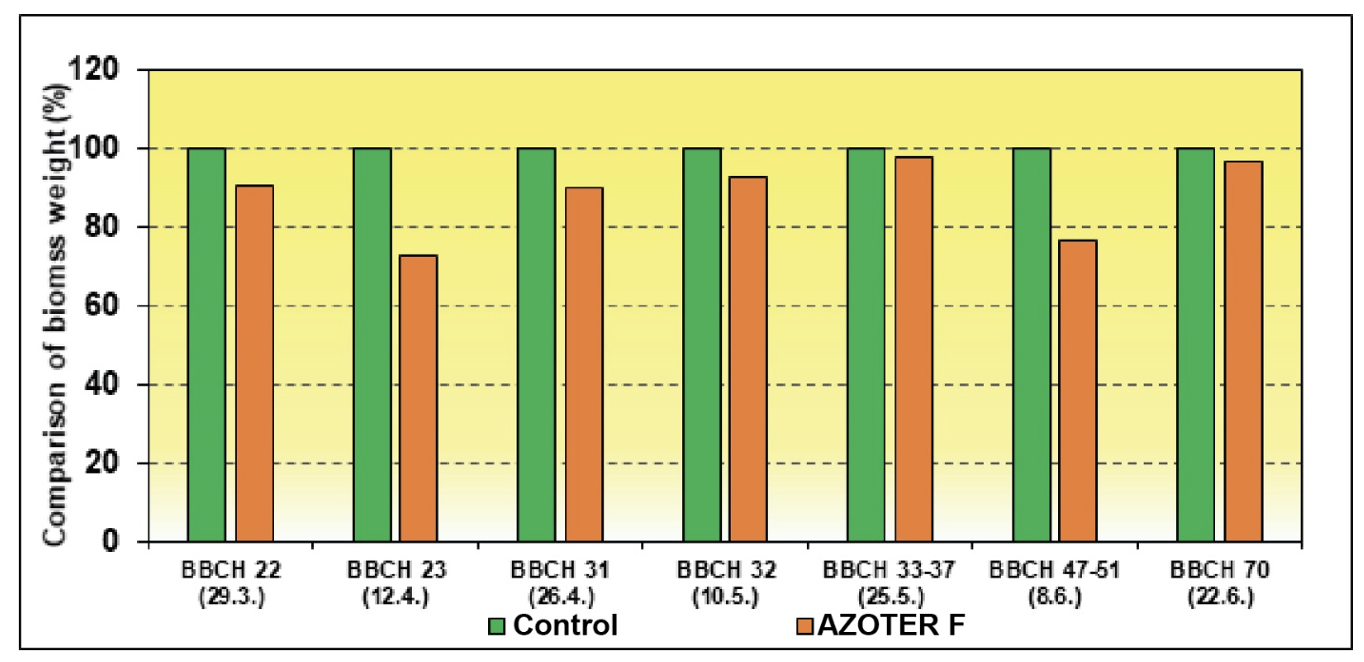
The nutritional health of the plants varied during the vegetation period. During jointing (BBCH 31, 26 April), the nutritional health with nitrogen and calcium was higher on the control plots. On the plots treated with AZOTER F, the nutritional health of phosphorus and magnesium was higher. Potassium was at the same level in both monitored plots.
During the beginning of the early maturity of the grain (BBCH 70, on 22 June), the nutritional health of nitrogen was higher on the control plot. On the plot treated with AZOTER F the nutritional state of phosphorus, potassium, and calcium was higher. Magnesium was at the same level in both monitored plots (Graph 2).
Graph 2. Comparison of the nutritional health of plants with nitrogen, phosphorus, potassium, calcium, and magnesium for the model grain yield in the period of tillering (BBCH 31) and at the end of vegetation period at the beginning of early maturity of grain (BBCH 70)
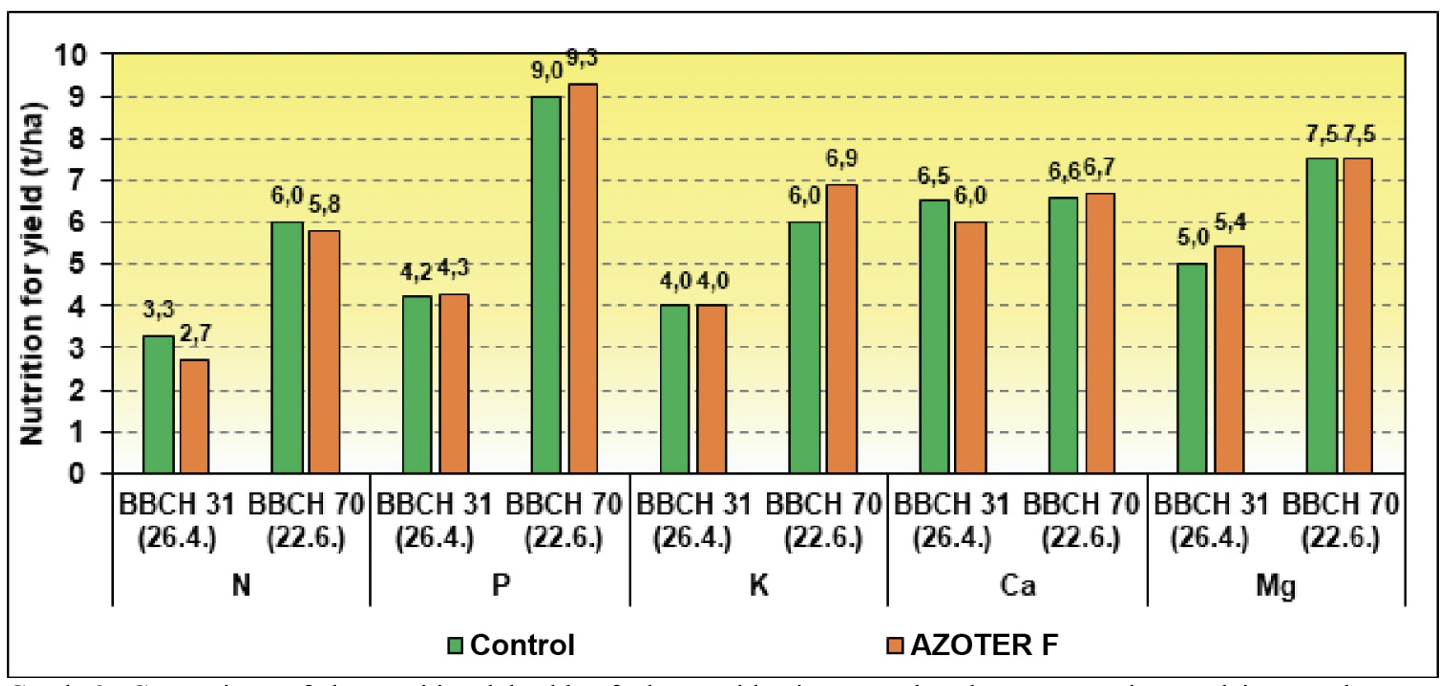
| Average number of shoots on plants in the monitored period according to treatment variants | ||||||||
| Period | BBCH 22 (29.3.) | BBCH 23 (12.4.) | BBCH 31 (26.4.) | BBCH
31-32 (10.5.) |
BBCH 33-37 (25.5.) | BBCH 47-51 (8.6.) | BBCH 70 (22.6.) | Vegetation total |
| Control | 1,5 | 1,6 | 2,3 | 2,3 | 1,8 | 1,8 | 1,8 | 1,9 |
| AZOTER F | 1,5 | 2,6 | 2,5 | 2,1 | 1,7 | 1,8 | 1,9 | 2,0 |
In detail, the plants received a total of 93 kg / ha of macronutrients (N, P, K, Ca and Mg) on the control plots during jointing (BBCH 31). Intake of nitrogen was 43 kg, intake of phosphorus was 4.5 kg, intake of potassium was 38 kg / ha, intake of calcium was 6 kg / ha and intake of magnesium was 1.6 kg / ha. On plots treated with AZOTER F, the plants received a total of 80 kg of nutrients per 1 ha. There was intake of nitrogen 35 kg, phosphorus 4.2 kg, potassium 35 kg / ha, calcium 5 kg / ha and magnesium 1.6 kg / ha. From the results of nutrient intake in the period of the first half of the vegetation (until jointing) it is evident that the intake of the main nutrients was higher on the control plots than after the application of the bacterial fertilizer. The plants on the control variant grew less and showed a higher increase in aboveground biomass, compared to the plant habit after AZOTER F application to the soil before sowing (Graph 3).
Graph 3. Biological intake of nutrient by above-ground wheat biomass in jointing (BBCH 31) on 26 April 2020
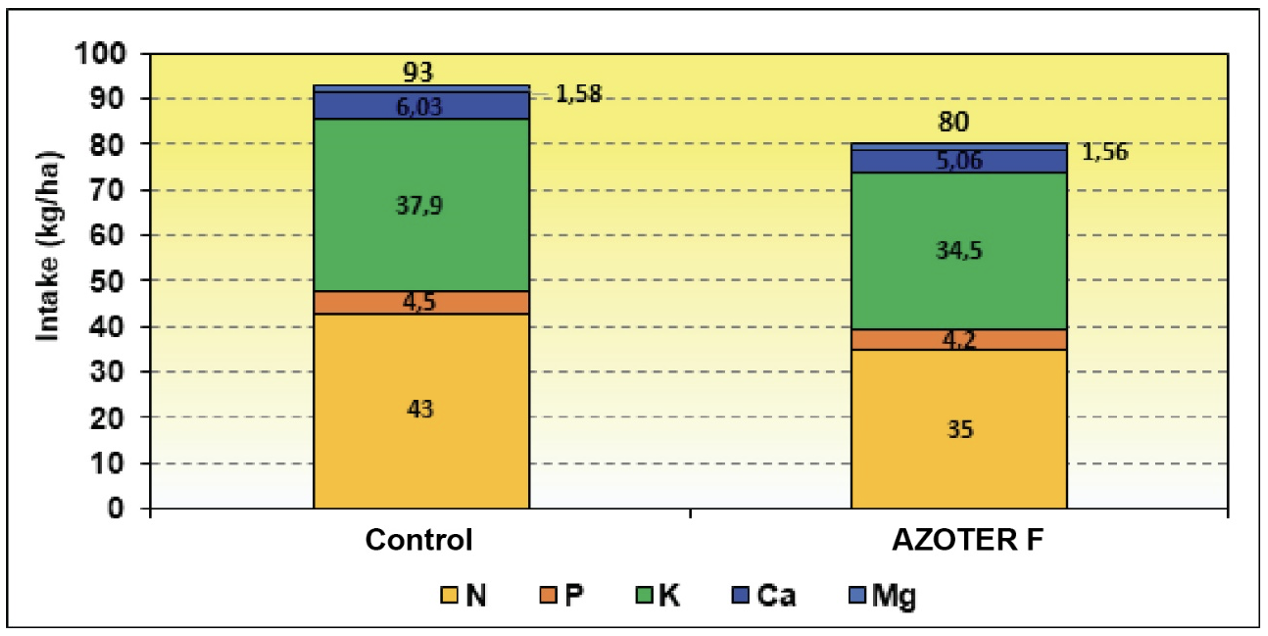
The trend of nutrient intake in the second half of the vegetation changed compared to the state in jointing period. During the early maturity period (BBCH 70), the stand received a total of 793 kg of macronutrients per 1 ha on the control variant. It was found that there was intake of nitrogen 309 kg, phosphorus 52 kg, potassium 365 kg / ha, calcium 47 kg / ha magnesium 21 kg / ha. After application of AZOTER F to the soil before sowing, nutrient intake of an average of 816 kg / ha was found, of which 282 kg of nitrogen, 54 kg of phosphorus, 413 kg / ha of potassium, 47 kg / ha of calcium and 20 kg / ha of magnesium. The tested AZOTER F preparation supported the growth and nutrition of plants more effectively, but the control plot without the application of AZOTER F preparation showed a higher nitrogen intake (Graph 4).
Graph 4. Biological intake of nutrient by above-ground wheat biomass in the early maturity period (BBCH 70) on 22 June 2020
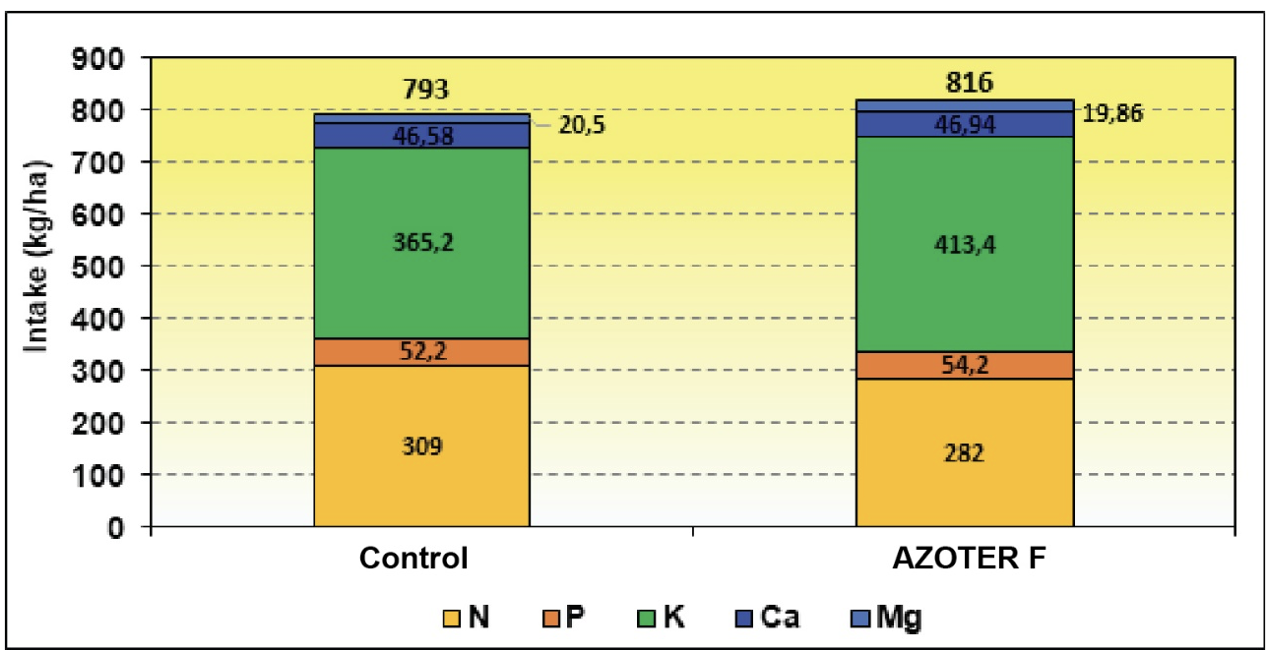
The soil under the stands showed a significantly lower content of mineral nitrogen (Nmin.) in the soil during the period of early maturity than in autumn before the experiment started. A good supply of Nmin was found before the establishment of the stand and AZOTER F application. In the summer 2020, in the period when the main nitrogen demand in wheat ended, a small supply of Nmin was recorded on the control variant and on the variant treated with AZOTER F. The growth on the control and after the application of AZOTER F showed a very good utilization of nitrogen from the soil (Table 2).
| Date of sampling | Variant treatment | Dry matter (%) | N-NO3 (mg/kg) | N-NH4 (mg/kg) | Nmin. (mg/kg) | Supply (category) | Supply (kg/ha) |
| 7.10.2019 | Experiment area | 74,72 | 24,10 | 6,54 | 30,66 | good | 123 |
| 22.6.2020 | Control | 73,11 | 0,46 | 5,41 | 5,87 | low | 23 |
| AZOTER F (10 l/ha) | 72,42 | 0,46 | 4,82 | 5,29 | low | 21 |
Tab. 2. Content of mineral nitrogen (Nmin.) in the soil before the experiment started and in summer at the beginning of the early maturity of wheat
Effect of soil temperature on the Nmin content in the soil in spring – test of vitality and abundance of bacteria in the soil after winter pre-sowing with AZOTER F application.
On March 2, 2020, a soil sample was taken from the winter wheat stand (without and after AZTER F application). It was stored at a constant temperature of 22 ° C. The sample was stored in pots in a moist condition for the period of 50 days until April 21, 2020. The content of mineral forms of nitrogen (Nmin.) was analyzed to determine the availability of Nmin content for the spring period on the variant with the application of AZOTER F preparation and to determine the activity of nitrogen fixing bacteria supported with the increased temperature (Table 3).
The soil from the pot, without AZOTER F application, showed that the content of Nmin was at the level that was on the monitored plot and after the application of the AZOTER F preparation, the soil in the pot fixed 15 kg N / ha more (by 48% more compared to the control). It was clear that with late spring warming of the soil, a higher fixation of N2 in the soil and better conditions for plant nutrition can be expected after AZOTER F application.
| Termination date | Variant treatment | Dry matter (%) | N-NO3 (mg/kg) | N-NH4 (mg/kg) | Nmin. (mg/kg) | Supply (category) | Supply (kg/ha) |
| 21.4.2020 | Control | 84,28 | 4,10 | 3,71 | 7,81 | Low | 31 |
| AZOTER F | 87,27 | 7,97 | 3,54 | 11,52 | medium | 46 |
Tab. 3. Mineral nitrogen content (Nmin.) after 50 days of incubation in pots at 22 ° C
Applicator for AZOTER F fertilizer installed on a pre-sowing cultivator (compactor)
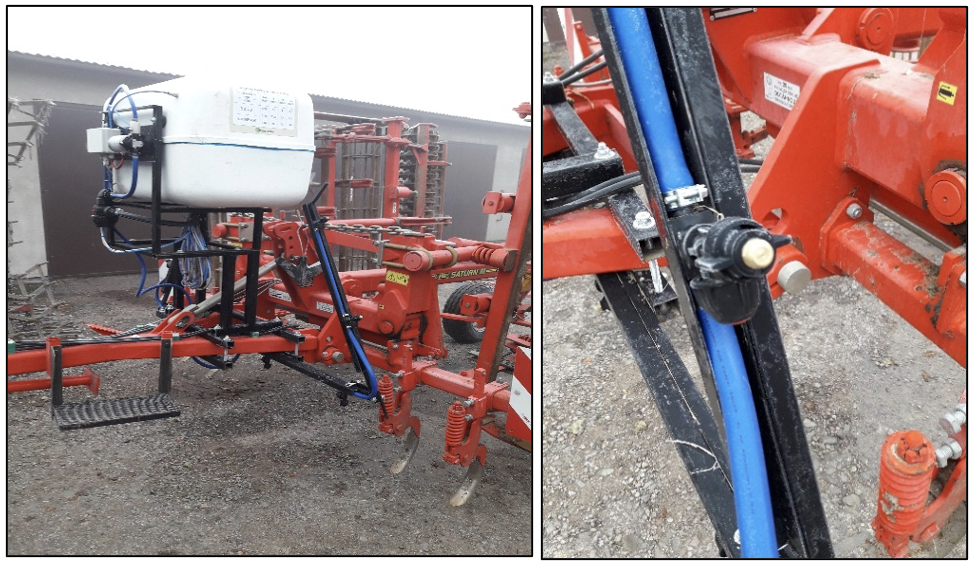
At temperatures below 20 ° C, there was no significant fixation of N2 to soil bacteria. At the end of the wheat vegetation, soil temperature increased and fixation of N2 was higher. During the whole vegetation of winter wheat, the soil temperature was around 10 – 15 ° C, which turned out to be a less satisfactory temperature for soil bacteria. The graph shows that the nitrogen supply was higher throughout the vegetation of the wheat on the control plot. At the end of the vegetation, when the soil temperature went up, the nitrogen supply in the soil tended to increase. Nitrogen intake by the plant stands on the control variant treated with AZOTER application was higher than the rate of fixation and possible mineralization of nitrogen in the soil (Graph 5).
Graph 5. The effect of soil temperature on nitrogen supply (Nmin.) in the soil in winter wheat stand
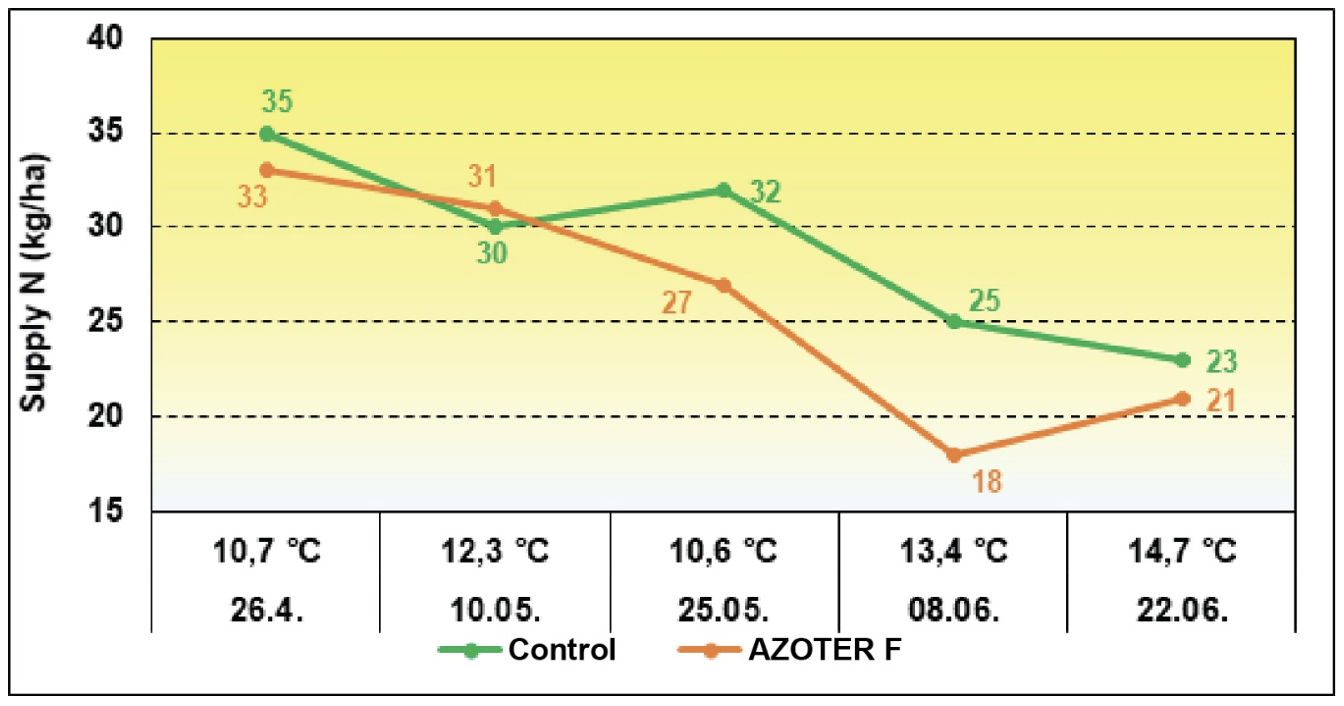
Marked control plot without AZOTER F application before sowing of winter wheat (October 15, 2019)
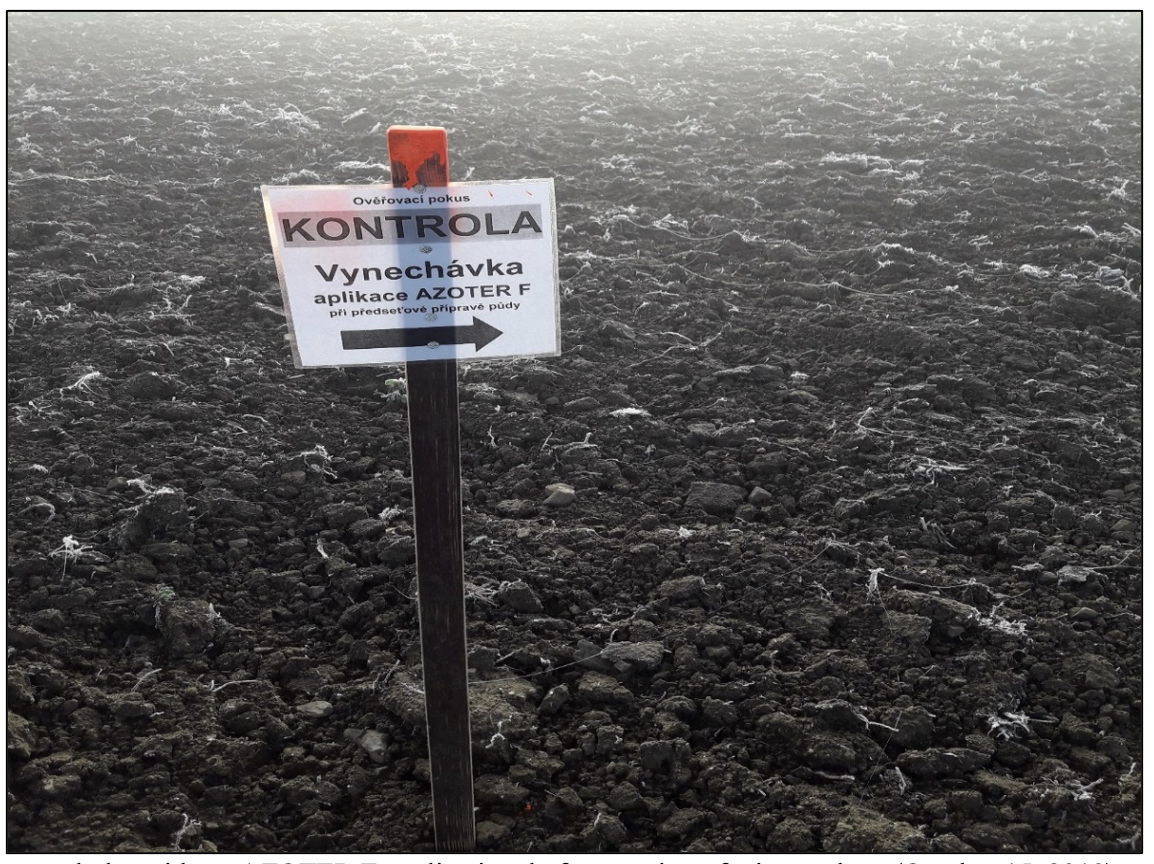
After AZOTER F application in pre-sowing soil preparation, the harvest yield of grain was by 9% higher compared to the control where the application wasn´t used. On the control plot, the grain yield of 4.14 t / ha was found. After the application of the tested AZOTER F fertilizer to the soil before sowing, a grain yield of 4.49 t / ha was found (graph 6). After the application of AZOTER soil bacteria fertilizer, due to the delayed and final warming of the soil, nitrogen was made available to the plants and the formation of grain yield was strengthened.
In the control variant, the stand took about 17.6 kg N / t of yield and after applying AZOTER F to the soil before sowing, the stand took about 17.8 kg N / t of yield.
Graph 6. The effect of pre-sowing AZOTER F application on winter wheat grain yield (at 14% humidity)
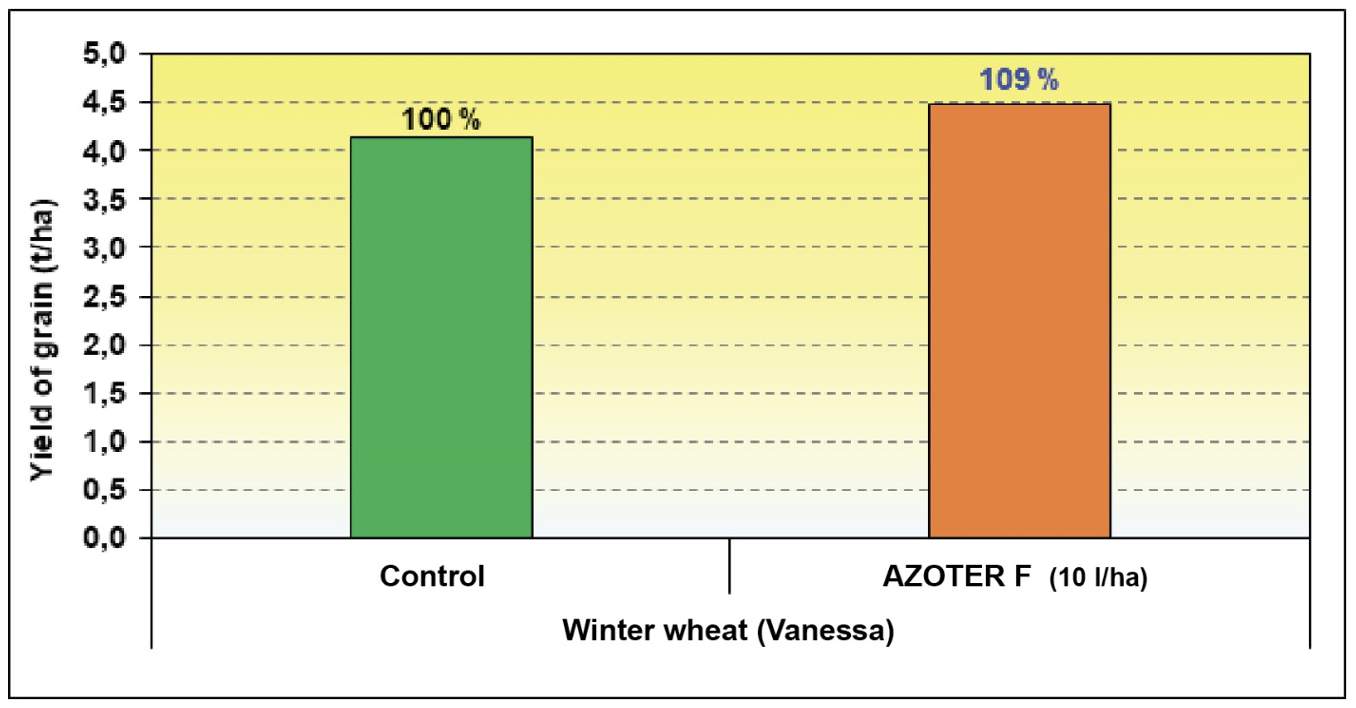
| Nitrogen uptake of wheat grain in harvest | ||
| Uptake | Control | AZOTER F |
| kg N/ha: | 63 | 69 |
| kg N/t: | 17,6 | 17,8 |
The control variant without AZOTER F application showed a higher number of ears, slightly higher TGW and lower grain bulk density than on the monitored plot with AZOTER F fertilizer. The control revealed the amount of 590 ears / m2, 33.99 g TGW and 751 g / l bulk density of the grain. On the variant with AZOTER F application, the number of ears was 536 pcs / m2, 33.98 g TGW and 752 g / l bulk density of the grain. Differences in the yield were minimal. Achieving a higher yield after AZOTER F application was mainly ensured by a higher balance of the stand on the plot and a slightly higher number of grains per ear (Table 4).
| Variant treatment | Number of ears (ks/m2) | TGW (g) | Bulk density of grain (g/l) |
| Control | 590 | 33,99 | 751 |
| AZOTER F | 536 | 33,98 | 752 |
Tab. 4. The effect of AZOTER F application on the selected yield-generating components
The grain quality and higher content of nitrogenous substances (NL) at the level of 11.10% was found on the plot after AZOTER F application before sowing the wheat. On the control plot, the content of NL was similar to that after the application of the bacteria fertilizer, namely 11.05% (Table 5). The content of N-substances in the grain was lower, which was determined by the cultivation of the feed variety. The starch content was slightly lower in the control variant (61.85%) than in the variant with applied AZOTER F (62.10%). On the plots treated with AZOTER F, the actual grain size in terms of area, was larger than on the control plots. The width and length of the grain was insignificantly different between the individual stands (Table 5).
| Variant treatment | Content of
N-substances (%) |
Starch content (%) | Grain area (mm2) | Width of grain (mm) | Lenght of grain (mm) |
| Control | 11,05 | 61,85 | 15,4 ±0,5 | 3,3 ±0,1 | 6,2 ±0,1 |
| AZOTER F | 11,10 | 62,10 | 15,7 ±0,4 | 3,3 ±0,0 | 6,3 ±0,1 |
Tab. 5. The effect of AZOTER F application on wheat grain quality
Economic evaluation: The effect of the application of AZOTER F bacteria fertilizer applied into the soil before sowing was positive. AZOTER F application showed a 9% higher grain yield than the control without application. With using AZOTER F application there was an increase in the sales by CZK 1.818 / ha compared to standard agricultural technology without the fertilizer application (control). The cost of AZOTER F fertilizer was CZK 900 l / ha for the recommended dose of 10 l / ha. Application using an installed applicator on a pre-sowing cultivator (compactor) brings minimal costs (up to 30 CZK / ha). At the price of wheat grain (CZK 5.200 / t) at the organic commodities marketplaces, the sales revenue from the harvest were CZK 21.531 / ha on the control variant without the application of AZOTER F. After AZOTER F application, the sales revenue was CZK 23.349 / ha. After deducting direct costs for the innovative growing technology, ie for the fertilizer and its application (CZK 930 / ha), the increase in sales was by CZK 1.818 / ha. Net increase in sales was around CZK 888 / ha (Graph 7).
Graph 7. The effect of pre-sowing application of AZOTER F on sales of winter wheat grain in average organic quality (year 2020)
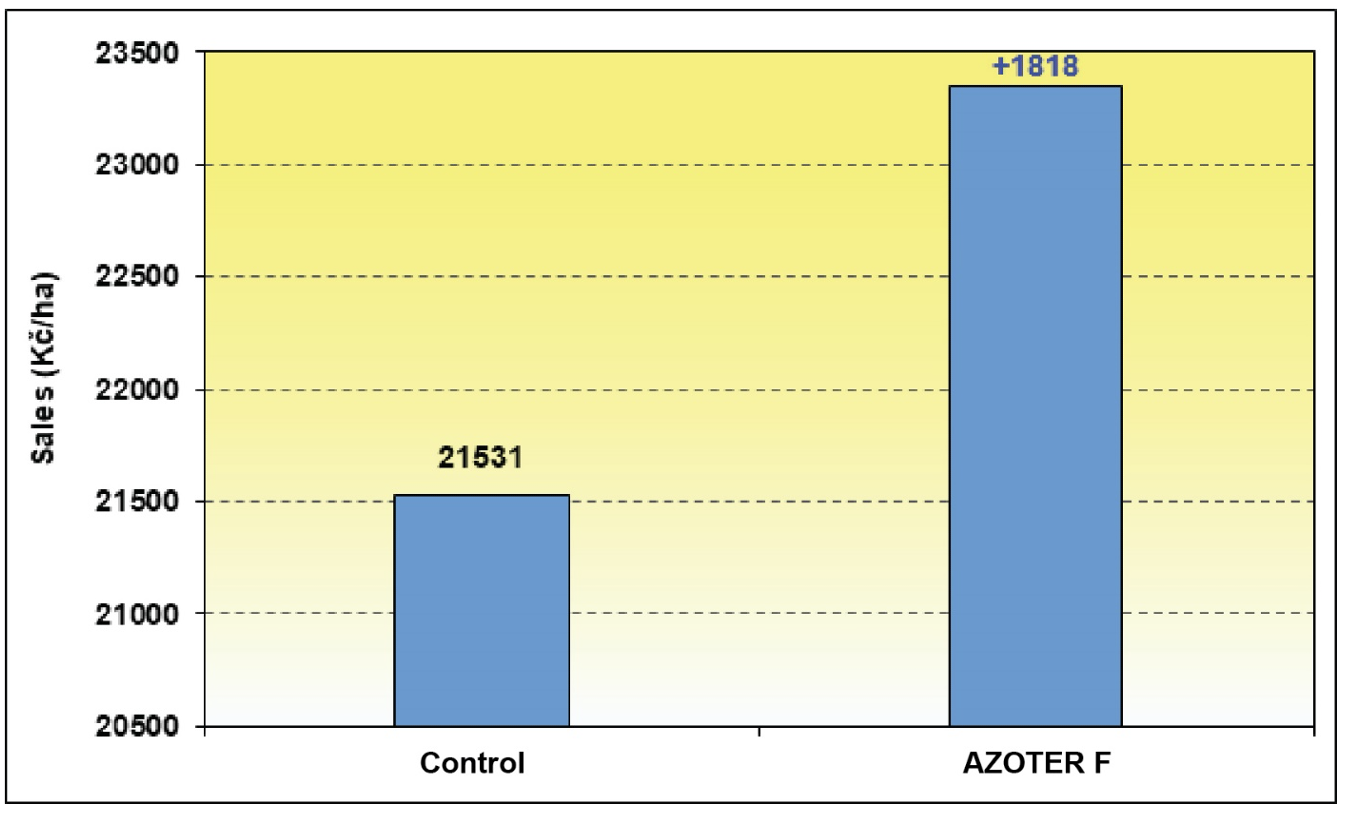
Spring barley in the cadastral area of Prostřední Lipka (okres Ústí nad Orlicí)
Soil type: medium heavy (gleyic cambisol and planosol and stagnosol modal on granite,gneiss, and other solid rocks), slightly to medium stony, with a tendency to temporary surficial wetting, average altitude 553 m
| Organic matter (%) | Soip PH | Content of available nutrients (mg / kg of soil) | ||||
| Cox. | pH/CaCl2 | Nmin. | P | K | Ca | Mg |
| 3,03 | 5,62 | 12,3 | 38 | 364 | 1697 | 257 |
| Very high | Slightly acidic | Medium supply | Low | High | Satisfactory | Good |
Tab. 6. Agrochemical properties of soil on the plot before AZOTER F application (March 31, 2020)
The application of AZOTER F bacteria fertilizer (10 l / ha) was carried out on the day of sowing the barley in the spring on 3 April 2020 with using the applicator installed on a pre-sowing cultivator with immediate incorporation into the soil to a depth of 5 – 6 cm. On March 26, 2020, cattle manure was spread and plowed into the monitored plot at a dose of 45 t / ha. A stand with the Bojos variety in usual plowing technology was established. The harvest took place on August 27, 2020.
During the whole vegetation, the stands of spring barley showed unbalanced growth. After the application of AZOTER F, the higher dry weight of aboveground biomass on the control plots was found at the beginning of vegetation, and then for the rest of the vegetation, there was higher weight of biomass (Graph 8).
Graph 8. The effect of AZOTER F application on dry weight of above-ground biomass of barley plants in the period of whole vegetation
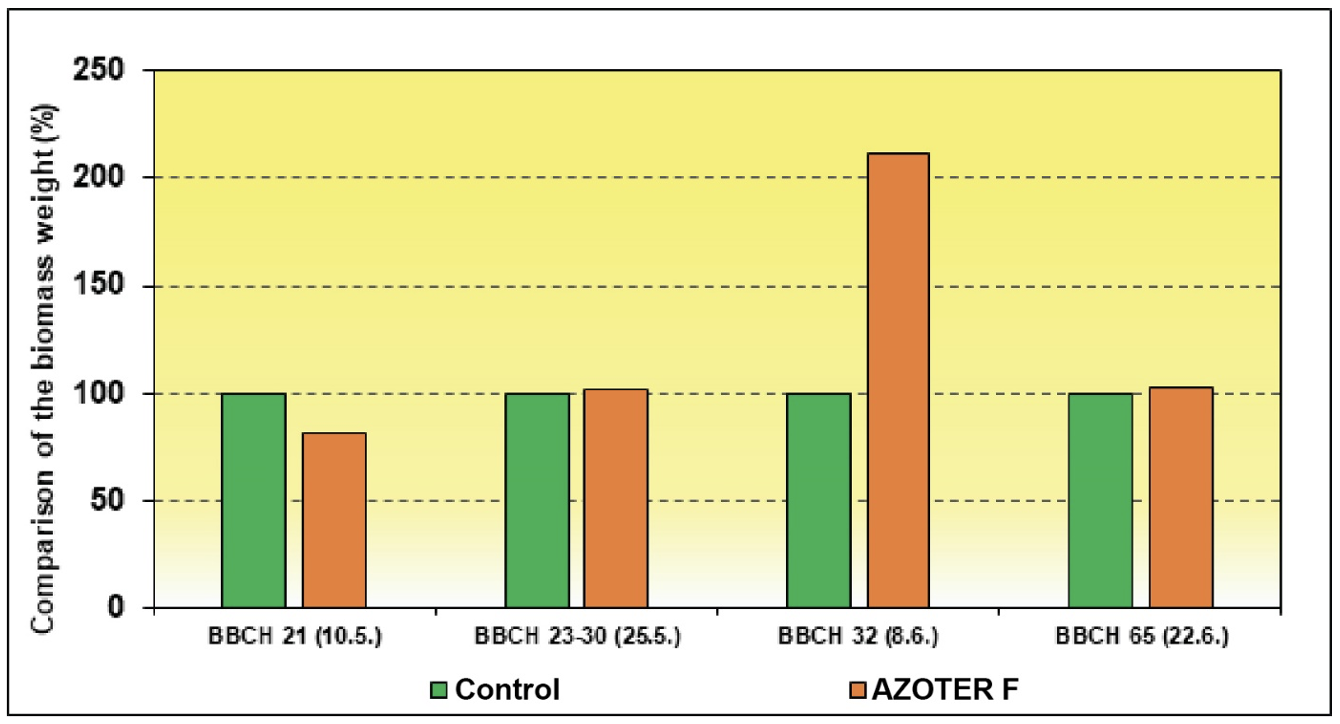
The nutritional health of plants was different during the vegetation. At the beginning of jointing (BBCH 30), the nutritional health was higher with nitrogen, calcium and magnesium on the plots treated with AZOTER F. The nutritional health on the control plots was higher with phosphorus and potassium. During the full flowering season (BBCH 65), the nutritional health was higher with nitrogen, phosphorus, calcium and magnesium on the plots treated with AZOTER F. The nutritional health on the control plot was higher with potassium (Graph 9).
Graph 9. Comparison of nutritional health of plants with nitrogen, phosphorus, potassium, calcium and magnesium for the model grain yield in the period of jointing (BBCH 30) and at the end of vegetation in the period of full flowering stage (BBCH 65)
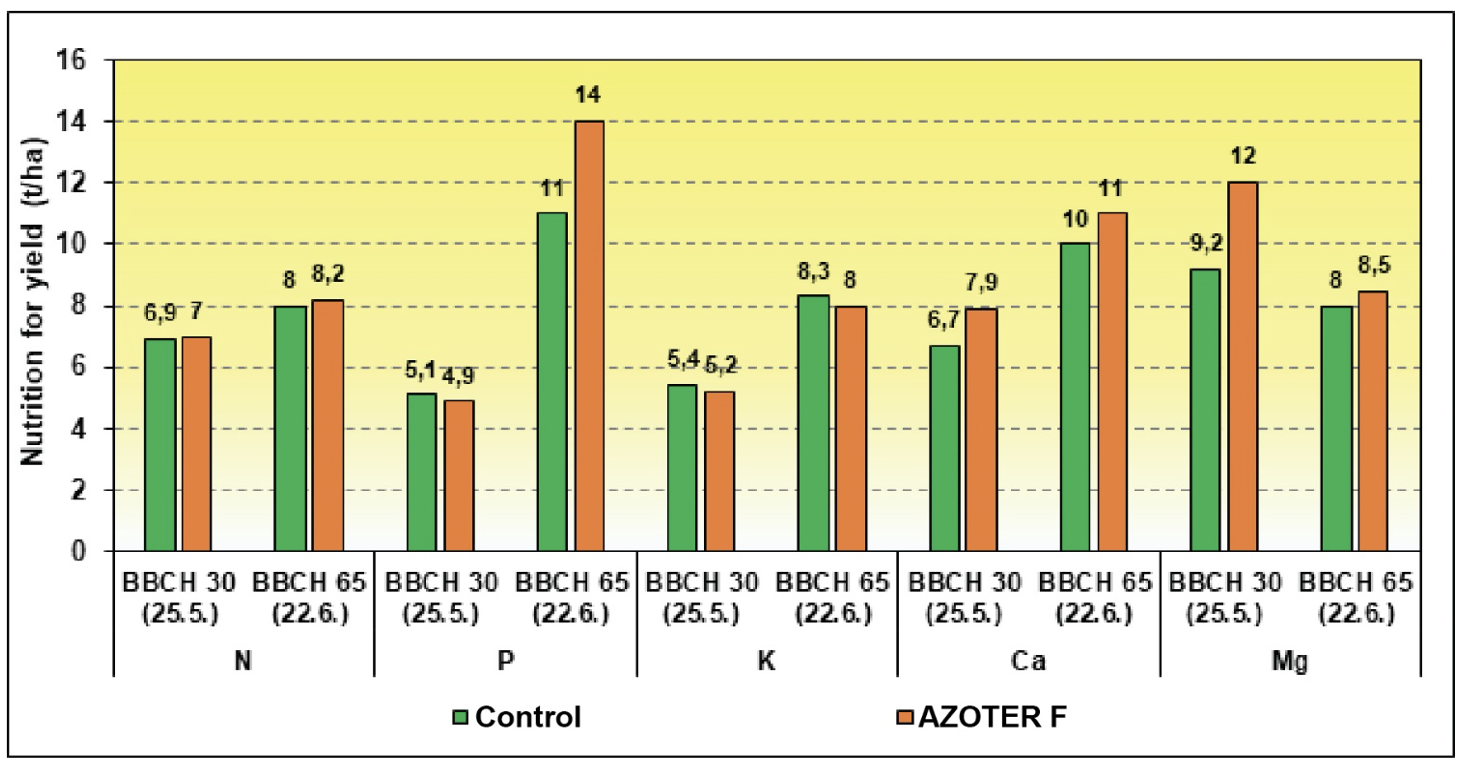
| Average number of shoots on plants in the monitored period according to treatment variants | |||||
| Period | BBCH 21 (10.5.) | BBCH 23-30 (25.5.) | BBCH 32 (8.6.) | BBCH 65 (22.6.) | Vegetation total |
| Control | 1,5 | 2,7 | 3,4 | 2,9 | 2,6 |
| AZOTER F | 1,3 | 2,5 | 4,2 | 3,3 | 2,8 |
At the beginning of jointing (BBCH 30), the plants received a total of 145 kg / ha of macronutrients (N, P, K, Ca and Mg) on the control plot. There was intake of nitrogen 65 kg, phosphorus 5,6 kg, potassium 61 kg, calcium 10 kg and magnesium 3,1 kg / ha. On the plot treated with AZOTER F, the plants received a total of 152 kg / ha. There was intake of nitrogen 69 kg, phosphorus 5.5 kg, potassium 61 kg, calcium 12.3 kg and magnesium 4.3 kg / ha. From the results of nutrient intake in the period of the first half of vegetation (until jointing) it is evident that the intake of the main nutrients was higher on the plot after applying AZOTER F bacteria fertilizer (Graph 10).
Graph 10. Biological nutrient intake of aboveground biomass of barley at the beginning of jointing (BBCH 30) on 2 25 May 2020
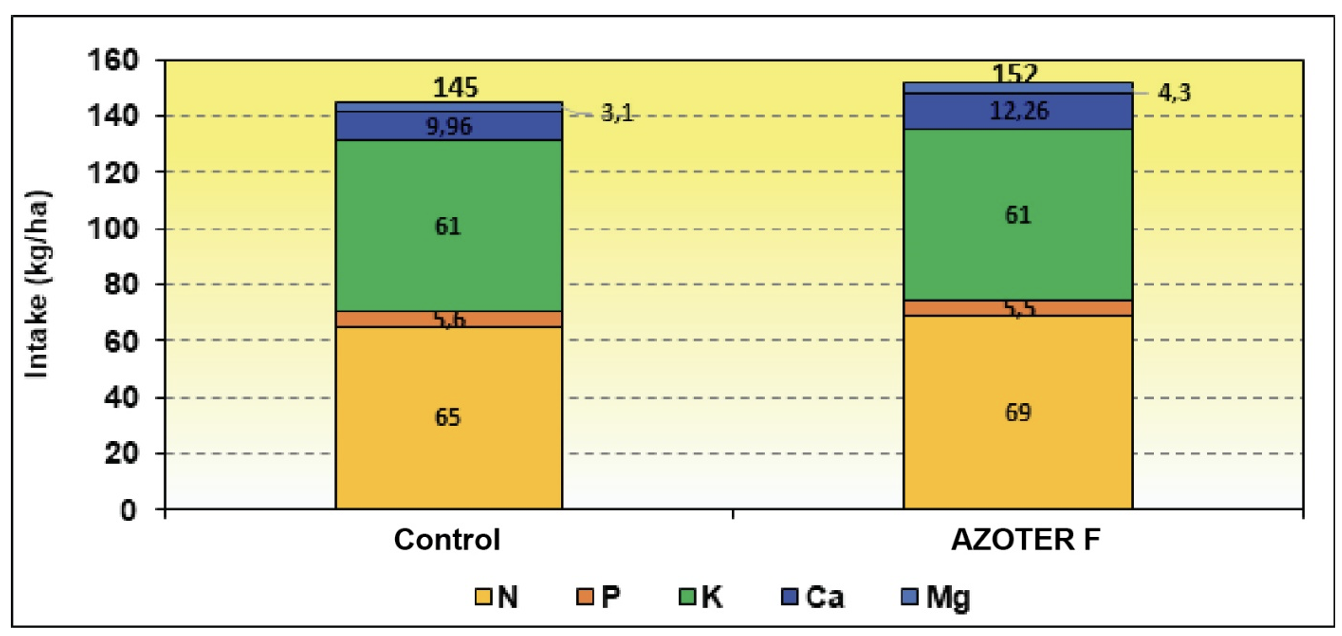
The trend of nutrient intake in the second half of the vegetation is similar to the one in the period of jointing. During the full flowering stage, the stand on the control variant received a total of 550 kg of main nutrients from 1 ha. There was the biological intake of nitrogen 185 kg, phosphorus 32 kg, potassium 280 kg / ha, 43 kg / ha of calcium and 11 kg / ha of magnesium. After AZOTER F application to the soil before sowing, the average nutrient intake of 597 kg / ha was detected, of which there were 210 kg of nitrogen, 40 kg of phosphorus, 287 kg / ha of potassium, 48 kg / ha of calcium and 12 kg / ha of magnesium. The tested AZOTER F fertilizer supported the growth and nutrition of plants more effectively (graph 11).
Graph 11. Biological nutrient intake of aboveground biomass of barley during the full flowering stage (BBCH 65) o on 22 June 2020
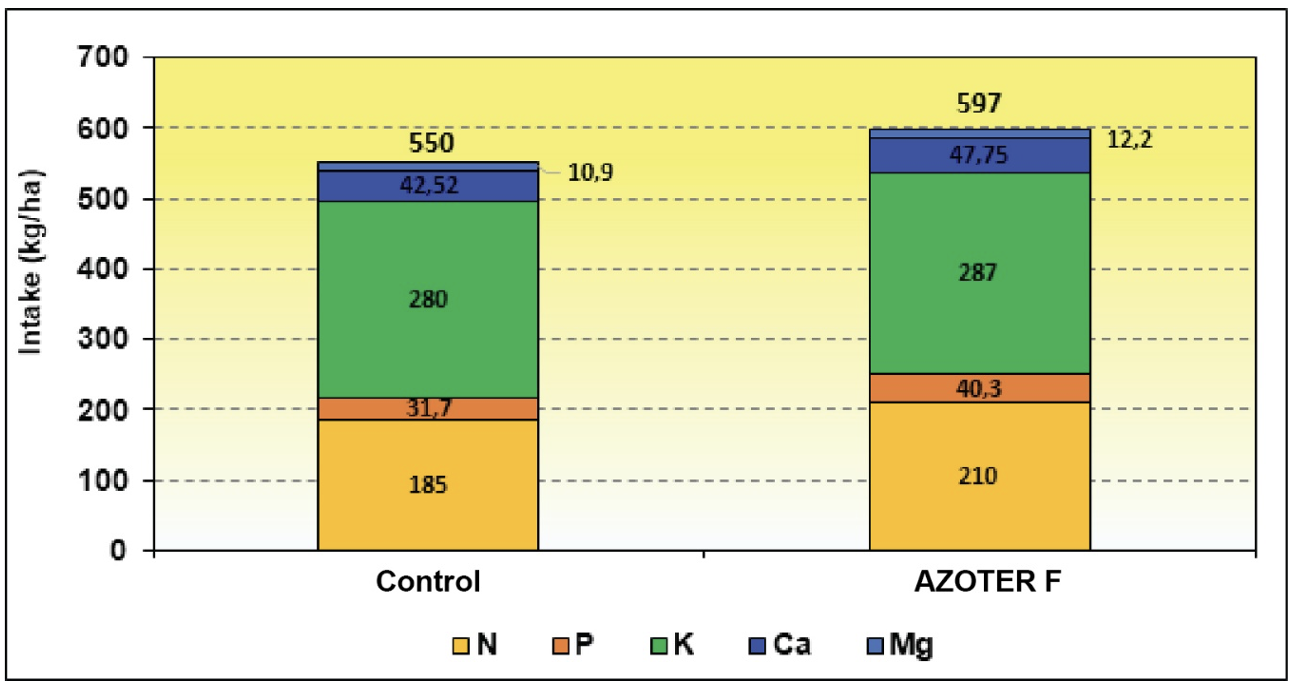
The soil under the plant stands showed a significantly lower content of mineral nitrogen (Nmin.) in the soil during the full flowering stage than in the spring before the beginning of the experiment. Before the stand formation and before the application of AZOTER F in the soil, medium supply of Nmin was detected. In summer 2020, when the main demand of nitrogen in barley was getting over, low supply of Nmin was recorded on the control variant and on the variant treated with AZOTER F. Low residual content of Nmin after flowering indicated good nitrogen utilization (Table 7).
| Date of sampling | Variant treatment | Dry matter (%) | N-NO3 (mg/kg) | N-NH4 (mg/kg) | Nmin. (mg/kg) | Supply (category) | Supply (kg/ha) |
| 31.3.2020 | Experiment area | 79,01 | 5,31 | 6,99 | 12,3 | Medium | 49 |
| 22.6.2020 | Control | 74,69 | 0,54 | 5,68 | 6,22 | Low | 25 |
| AZOTER F (10 l/ha) | 74,14 | 0,64 | 6,37 | 7,01 | Low | 28 |
Tab. 7. Mineral nitrogen content (Nmin.) in the soil before the establishment of the experiment and in the summer in full flowering time stage of barley
It is obvious, that similarly to the monitored plot of wheat, increasing soil temperature increases N2 fixation of soil bacteria as well. At the temperatures below 20 ° C, there was no significant fixation of N2 by soil bacteria and the soil wasn´t enriched with Nmin. The soil temperature didn´t increase until the end of the growing period of barley and N2 fixation was greater. During the whole vegetation of spring barley, the soil temperature moved around 10 – 15 ° C, which is not sufficient for the activity of soil bacteria. On the control plot, the nitrogen supply was higher almost throughout the barley vegetation. At the very end of the vegetation, when the soil temperature rose, the nitrogen supply in the soil tended to increase. In the second half of the vegetation, nitrogen uptake by plants prevailed over the soil’s ability to access mineral nitrogen in the soil. However, previous supply of Nmin in the soil was evident in the first half of the vegetation (especially after spring application) (Graph 12).
Graph 12. The effect of soil temperature on nitrogen supply (Nmin.) In soil in spring barley stand
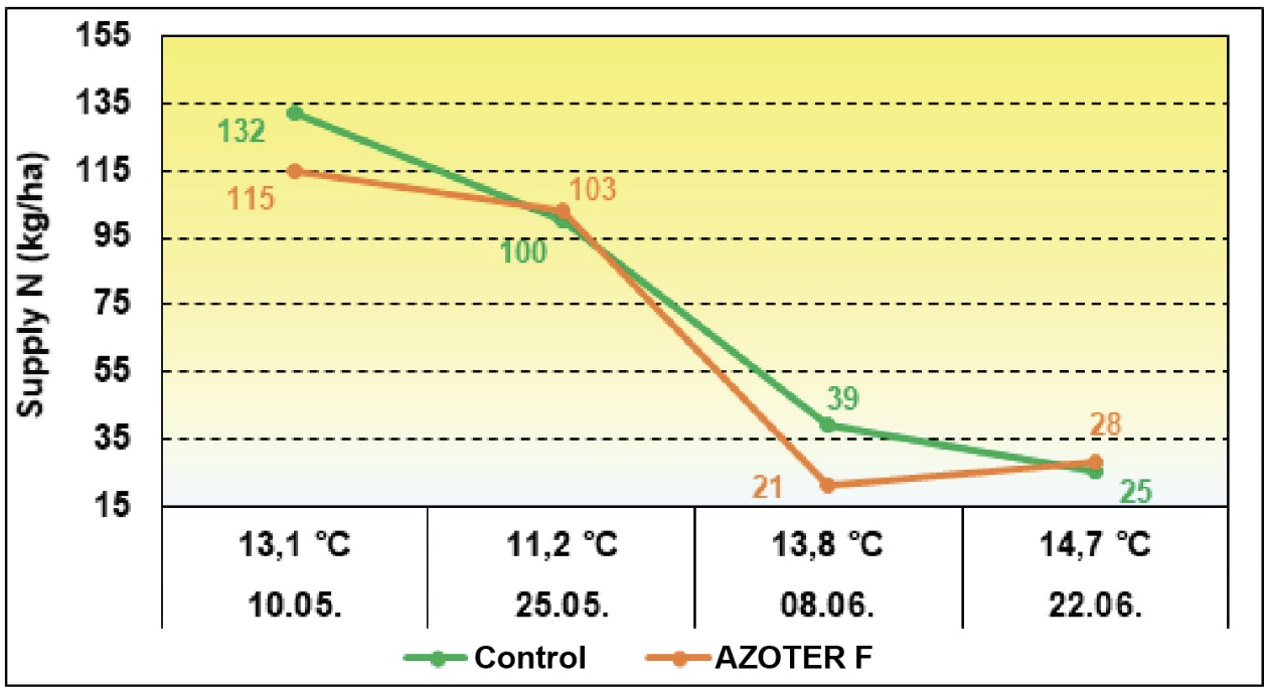
After AZOTER F application, the harvest yield of the grain was by 16% higher compared to the control without application. On the control variant, a grain yield of 3.83 t / ha was achieved. After AZOTER F application to the soil before sowing, a grain yield of 4.44 t / ha was found. The main effect of AZOTER F application on yield was in increasement in the number of ears at harvest and the size of the grain (Graph 13). The grain yield corresponded to nitrogen uptake. In the control variant, the nodes growth took 17.4 kg N / t of yield. After AZOTER F application to the soil before sowing, it collected about 17.9 kg N / t of yield.
Graph 13. Effect of pre-sowing AZOTER F application on the spring barley grain yield (at 14% humidity)
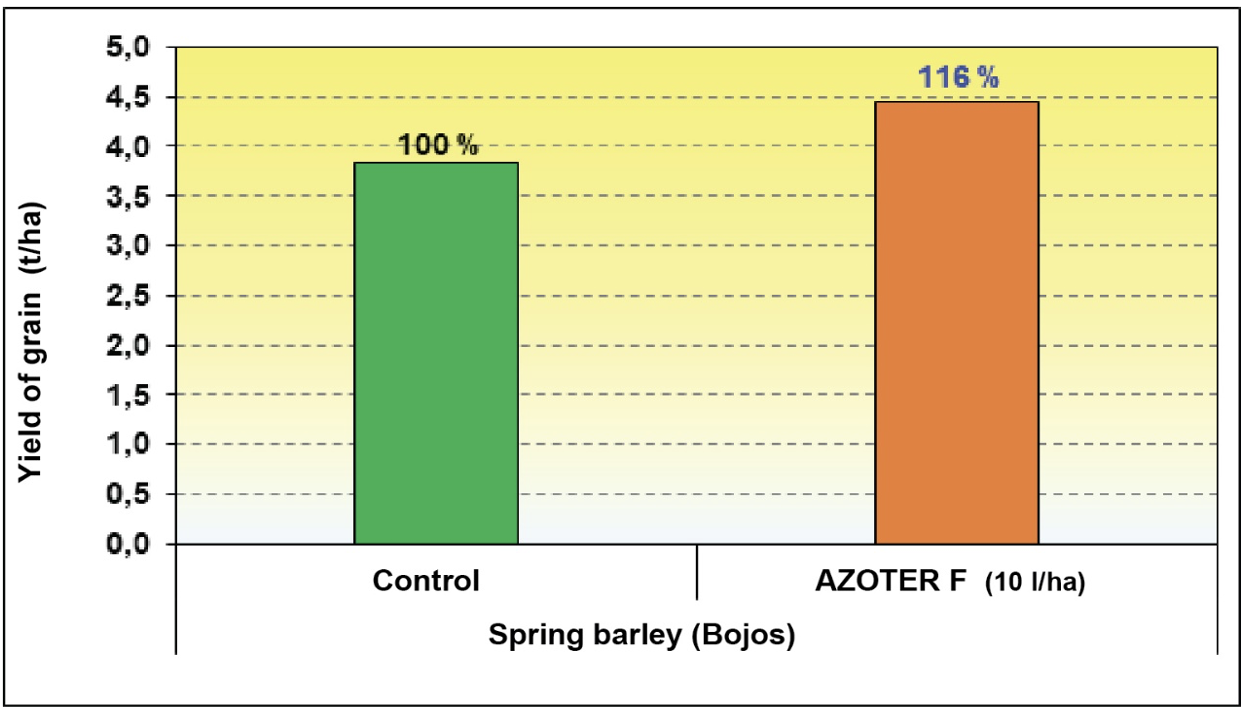
| Nitrogen uptake by barley grain in the harvest | ||
| Uptake | Control | AZOTER F |
| kg N/ha: | 58 | 69 |
| kg N/t: | 17,4 | 17,9 |
The control variant without AZOTER F application showed a slightly lower number of ears, lower TGW and lower grain bulk density than the monitored plot with AZOTER F application. There were 645 ears / m2, 39.40 g TGW and 712 g / l density on the control. There were 656 pcs of ears / m2, 41.86 g TGW and the bulk density of the grain was76 (g / l) on the variant with AZOTER F application (Table 8).
| Variant treatment | Number of ears (ks/m2) | TGW (g) | Bulk density of the grain (g/l) |
| Control | 645 | 39,40 | 712 |
| AZOTER F | 656 | 41,86 | 746 |
Tab. 8. The effect of AZOTER F application on selected yield-producing elements.
According to the nitrogen content (NL), the quality of barley grain after AZOTER F application before sowing was 11,20%. The nitrogen content on the control plot was 10,85%. In both stands, the nitrogen content was suitable for malting. On the control variant, the starch content was lower (57,5%). On the plots treated with AZOTER F, the starch content was 58,2%. The size and the length of the grain was higher on the control plot. The grain width was the same on both monitored plots (Table 9).
| Variant treatment | Content of
N-substances (%) |
Starch content * (%) | The size of the grain (mm2) | Width of grain (mm) | Lenght of grain (mm) |
| Control | 10,85 | 57,5 | 20,6 | 3,8 | 7,8 |
| Azoter F | 11,20 | 58,15 | 20,0 | 3,8 | 7,6 |
Tab. 9. The effect of AZOTER F application on the quality of spring barley grain
Economic evaluation: The effect of AZOTER F bacterial fertilizer with the application before sowing into the soil was positive. AZOTER F application achieved higher grain yield by 16% compared to the control without application. The innovation of growing technology ensured an increase in gross sales to CZK 24.450 / ha, which is an increase by CZK 3.355 / ha. After deducting the direct costs (CZK 930,00 / ha per product and for the application using an applicator installed on a cultivator – pre-sowing compactor), net sales were by CZK 2.425 / ha higher than the control, where standard technology was used. The average price of spring barley grain on the organic commodities market was CZK 5.500 / t (Graph 14).
Graph 14. The effect of pre-sowing application of AZOTER F on the sales of spring barley grain in average bioquality (year 2020)
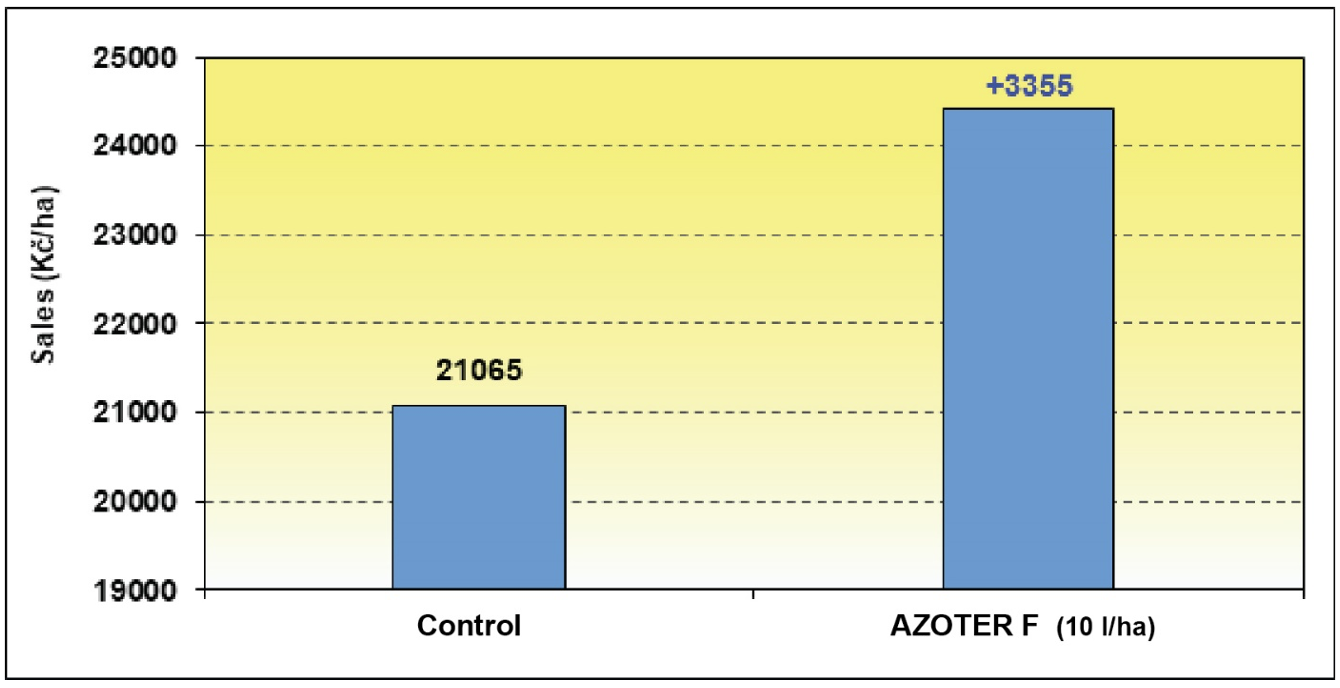
Conclusion
The application of AZOTER F bacterial fertilizer before sowing winter wheat and spring barley has resulted in a comprehensive increase in grain yield in the cultivation technology. In comparison with the control plot cultivated with the traditional technology without using the fertilizer, grain yield increased by 9%, a wheat yield increased by 16%. The effect on yield formation in winter wheat was found at the end of the vegetation period. The effect on yield formation of spring barley was found at the jointing period of the stand, ie mainly in the grains, in the second half of the vegetation.
In the conditions of organic production, the influence of soil temperature on the content of mineral forms of nitrogen (Nmin.) has been detected. It was formed in the innovated cultivation technology by supporting the natural fixation of N2 from the atmosphere into the soil. It is evident that the soil bacteria supplied with AZOTER F to promote N2 fixation thrives on higher soil temperature (20 ° C) which makes Nmin in the soil available for plants. Thus, the effect of AZOTER F in the soil at higher altitudes was found mainly in the second half of the grain vegetation. The results of a one-year experiment with the tested AZOTER F preparation show a positive effect on grain quality.
From the economic point of view, the benefit of AZOTER F fertilizer before sowing, using a relatively easily installed applicator directly on the pre-sowing cultivator (compactor), was in increasing net sales of wheat grain by CZK 888 / ha and spring barley grain by CZK 2.425 / ha.
Recommendations to reach the greatest benefit of AZOTER F technology in organic farming:
- Plan to use the technology on the plot where the soil is in structural condition, treated by plowing or deep loosening with chisel in optimal physical condition, with previous regular supply of organic matter, most preferably with direct application of manure (30 – 40 t / ha) before basic tillage and subsequent application of AZOTER F before sowing.
- The best use of AZOTER F fertilizer is in the cloudy weather followed by immediate pre-sowing incorporation with a cultivator. From the economic point of view, the most favorable use is to apply the fertilizer directly with the applicator, installed directly on the pre-sowing cultivator (compactor), with immediate incorporation into the soil to a depth of min. 5 cm.
- For winter wheat, it is advisable to apply AZOTER F as soon as possible in early autumn, optimally after the basic tillage (ahead of the sowing date).
The result of the tested AZOTER F bacterial fertilizer was obtained in 2020 (growing season 2019/2020) from the established semi-operational field experiments for the customer (AZOTER CZ s.r.o) in an agricultural company with fully certified organic farming.
In Žamberk on November 3, 2020

